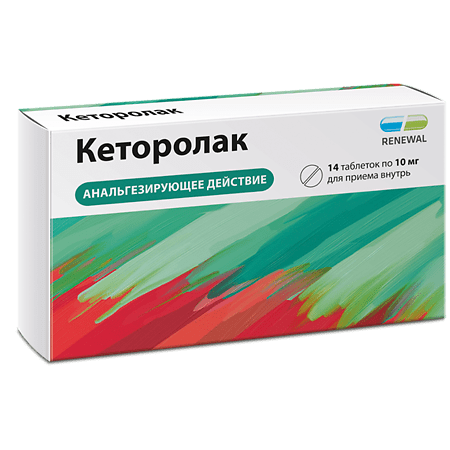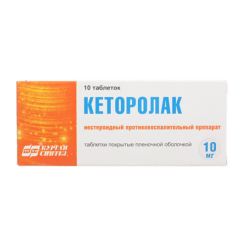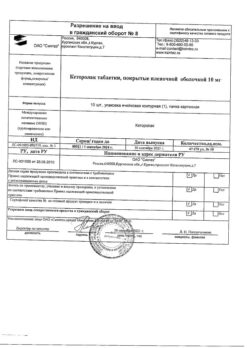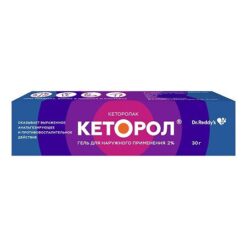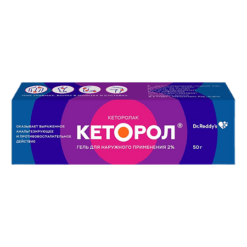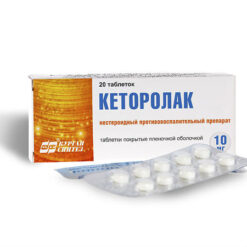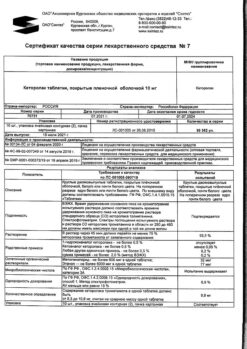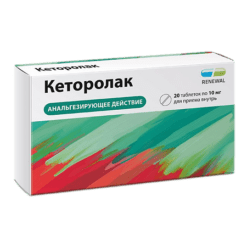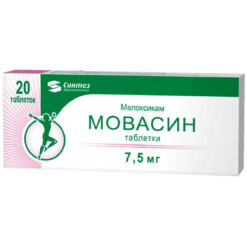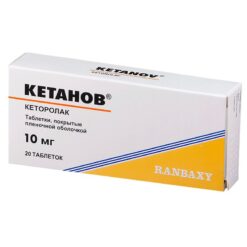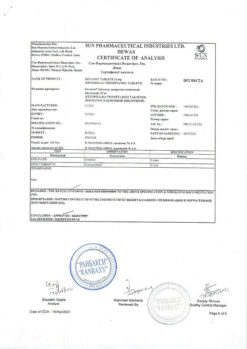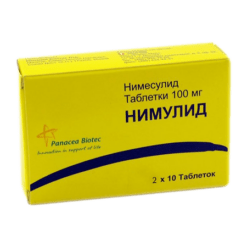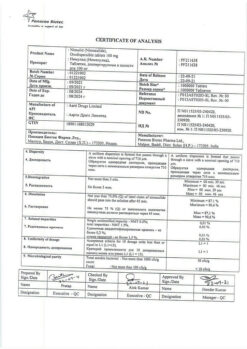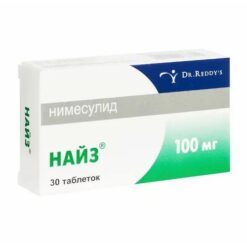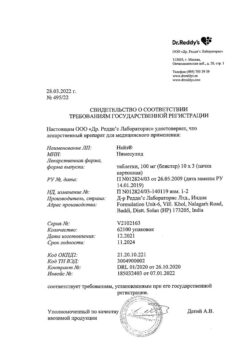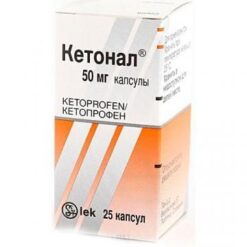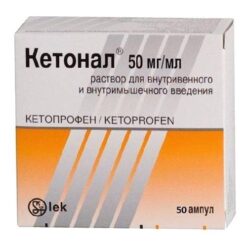No products in the cart.
Ketorolac Reneval, 10 mg 14 pcs
€1.64 €1.49
Description
Ketorolac has a pronounced analgesic effect, also has anti-inflammatory and moderate antipyretic effects. The mechanism of action is associated with non-selective inhibition of cyclooxygenase enzyme activity in peripheral tissues, resulting in inhibition of prostaglandin biosynthesis – modulators of pain sensitivity, thermoregulation and inflammation.
Ketorolac has no effect on opioid receptors, does not depress respiration, does not cause drug dependence, has no sedative and anxiolytic action.
After oral administration the onset of analgesic effect is observed after 1 hour, the maximum effect is achieved after 1-2 hours.
Indications
Indications
Pain syndrome of strong and moderate intensity:
– injuries;
– toothache;
– pain in the postpartum and postoperative period;
– oncological diseases;
– myalgia;
– arthralgia;
– neuralgia;
– radiculitis;
– dislocations, sprains;
– rheumatic diseases.
Pharmacological effect
Pharmacological effect
Ketorolac has a pronounced analgesic effect and also has anti-inflammatory and moderate antipyretic effects. The mechanism of action is associated with non-selective inhibition of the activity of the cyclooxygenase enzyme in peripheral tissues, resulting in inhibition of the biosynthesis of prostaglandins – modulators of pain sensitivity, thermoregulation and inflammation.
Ketorolac does not affect opioid receptors, does not depress respiration, does not cause drug dependence, and does not have a sedative or anxiolytic effect.
After oral administration, the onset of analgesic effect is observed after 1 hour, the maximum effect is achieved after 1-2 hours.
Active ingredient
Active ingredient
Ketorolac
Composition
Composition
Ketorolac (Ketorolac tromethamine) – 10.00 mg
Excipients:
microcrystalline cellulose – 122.41 mg
corn starch – 44.76 mg
colloidal silicon dioxide (aerosil) – 1.83 mg
magnesium stearate − 1.00 mg
Shell composition:
hypromellose – 2.91 mg
titanium dioxide – 1.25 mg
Macrogol 400 (polyethylene glycol 400) – 0.68 mg
talc – 0.16 mg
Contraindications
Contraindications
Hypersensitivity (including to other non-steroidal anti-inflammatory drugs);
complete or incomplete combination of bronchial asthma, recurrent polyposis of the nose and paranasal sinuses and intolerance to acetylsalicylic acid or other non-steroidal anti-inflammatory drugs (including a history);
erosive and ulcerative lesions of the gastrointestinal tract (GIT), active gastrointestinal bleeding;
inflammatory bowel diseases (including ulcerative colitis, Crohn’s disease);
diseases of the bone marrow and blood (leukopenia, including a history of thrombocytopenia, hypocoagulation (including hemophilia)), myelosuppression, bleeding or a high risk of their development;
severe renal failure (creatinine clearance (CC) less than 30 ml/min), confirmed hyperkalemia;
severe liver failure or active liver disease;
condition after coronary artery bypass surgery;
preventive pain relief before and during major surgical interventions due to the high risk of bleeding;
active cerebrovascular diseases (including intracranial hemorrhage or suspicion of it); pregnancy;
period of childbirth;
breastfeeding period; children under 16 years of age (safety and effectiveness of use have not been established);
simultaneous use with probenecid;
simultaneous use with pentoxifylline; simultaneous use with acetylsalicylic acid and other non-steroidal anti-inflammatory drugs (including cyclooxygenase-2 inhibitors);
simultaneous use with lithium salts;
simultaneous use with anticoagulants (including warfarin and heparin).
With caution:
Bronchial asthma; the presence of factors that increase gastrointestinal toxicity: alcoholism, smoking and cholecystitis; postoperative period; chronic heart failure; edema syndrome; arterial hypertension; moderate renal failure (creatinine clearance 30-60 ml/min); cholestasis; active hepatitis; sepsis; systemic lupus erythematosus; coronary heart disease; cerebrovascular diseases; dyslipidemia/hyperlipidemia; diabetes mellitus; peripheral arterial disease; a history of ulcerative lesions of the gastrointestinal tract, the presence of Helicobacter pylori infection; long-term use of NSAIDs; severe somatic diseases; thyroid diseases; tuberculosis; simultaneous use of oral glucocorticosteroids (including prednisolone), antiplatelet agents (including clopidogrel), selective serotonin reuptake inhibitors (including citalopram, fluoxetine, paroxetine, sertraline); old age (over 65 years).
Side Effects
Side Effects
The incidence of adverse events (AEs) is classified according to the recommendations of the World Health Organization, characterized as: very often – at least 10%; often – not less than 1%, but less than 10%; infrequently – not less than 0.1%, but less than 1%; rarely – not less than 0.01%, but less than 0.1%; very rare, including isolated cases – less than 0.01%; frequency unknown (frequency cannot be determined from available data).
Interaction
Interaction
The simultaneous use of ketorolac with acetylsalicylic acid or other NSAIDs, calcium preparations, glucocorticosteroids, ethanol, corticotropin can lead to a significant increase in the risk of adverse reactions, including the formation of gastrointestinal ulcers and the development of gastrointestinal bleeding.
Overdose
Overdose
Symptoms: abdominal pain, nausea, vomiting, peptic ulcers or erosive gastritis, impaired renal function, metabolic acidosis.
Treatment: gastric lavage, administration of adsorbents (activated carbon) and symptomatic therapy (maintaining vital functions in the body). Ketorolac is not sufficiently eliminated by hemodialysis.
Manufacturer
Manufacturer
Update of PFC JSC, Russia
Additional information
| Manufacturer | Update PFC AO, Russia |
|---|---|
| Medication form | pills |
| Brand | Update PFC AO |
Other forms…
Related products
Buy Ketorolac Reneval, 10 mg 14 pcs with delivery to USA, UK, Europe and over 120 other countries.

